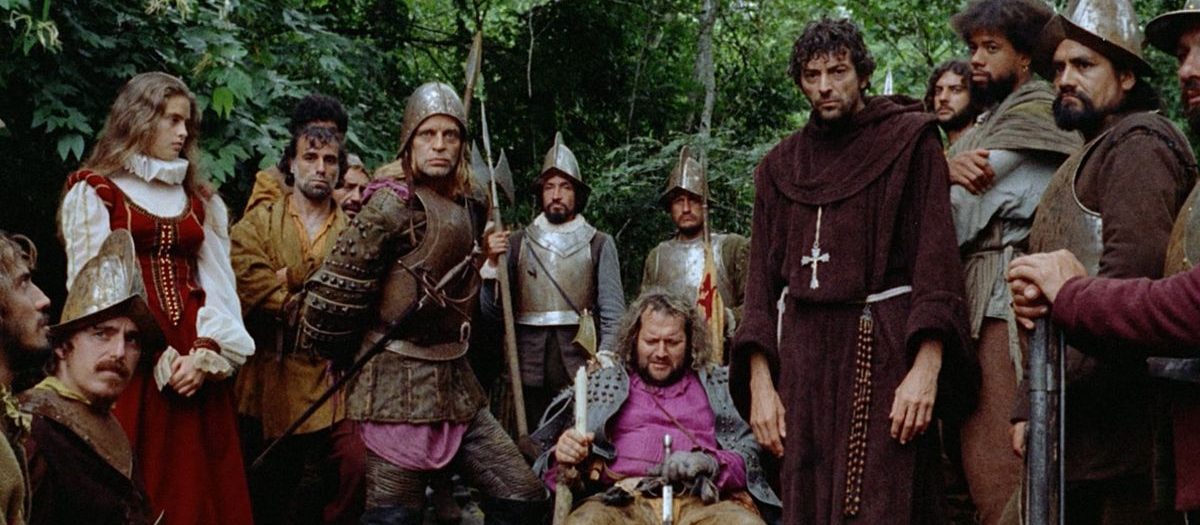
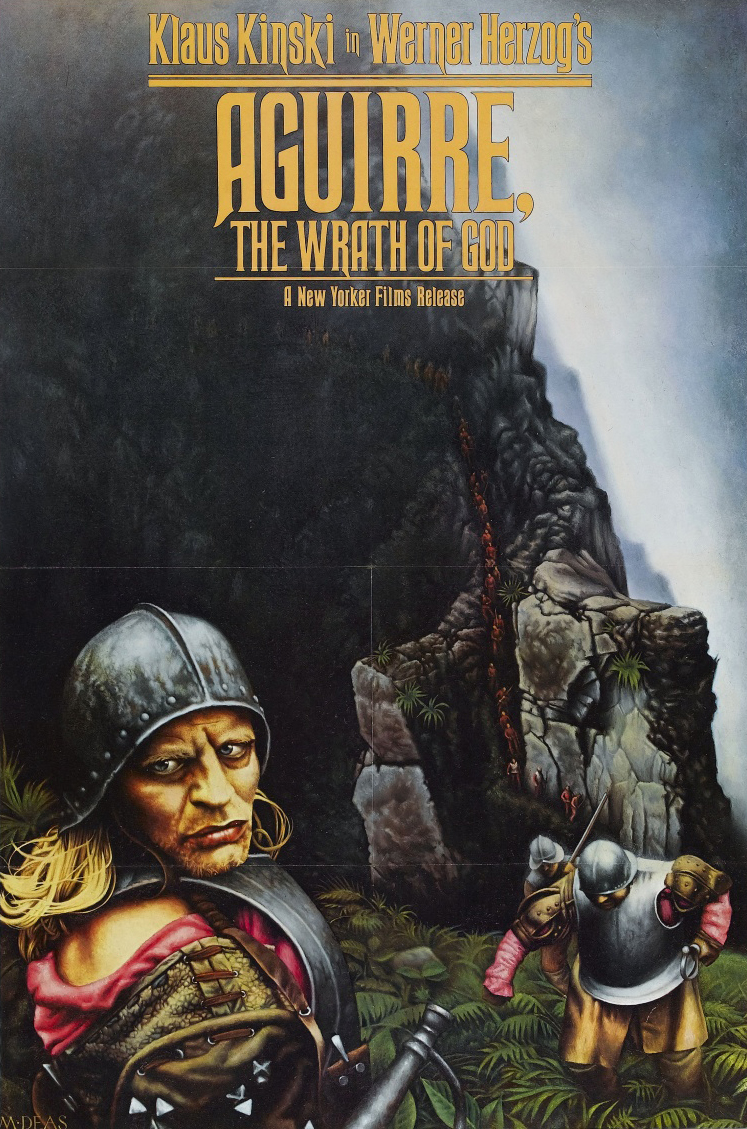
“We’ll stage history like others stage plays.”
A column of weary conquistadors, stretching impossibly from the top of the frame to the bottom, slowly climb their way down a treacherous path carved into the mountainside by Incas centuries in the past. The shot slowly pans downward to reveal even more men, some of them now foregrounded, others still almost indiscernible hundreds of feet up the trail. This majestic shot is held for nearly three minutes as Popol Vuh’s ethereal chorus lulls the viewer into a trance. The drawn out moment gives us a chance to grasp the scope of the production. Not only has Werner Herzog rounded up an impressively large cast and garbed them all in period attire, he’s actually led a procession of men, women, horses, pigs, and llamas on a treacherous expedition through the Peruvian jungle in pursuit of an authentic experience. The resulting footage captures hundreds of actors in full armor carefully wending their way down the treacherous mountain trail in the early morning fog. Matched with the beauty of the music, it’s so stunning as to justify the entire enterprise; truly one of the most awesome opening sequences I’ve seen. It was achieved without any effects.
There’s more than a touch of madness shared between Werner Herzog, Klaus Kinski, and the subject of their first film together, Lope de Aguirre. For Herzog, there should be no separation between the artist and his art. He views cinema, his chosen medium, as a participatory artform, only authenticated once the filmmaker has come to know his subject intimately. In his documentaries, he’s often found himself intricately tied up in the final product because he is not an after-the-fact observer but an active participant. He treats his narrative films the same way. Case in point is Aguirre, the Wrath of God, debatably his first true rendition of his familiar descent into madness, but almost certainly the first Herzog picture where the absurdity of the plot is matched (if not exceeded) by the perils of the filmmaking process. Indeed, reading about the production is nearly as exhilarating as watching the film, as the arduous journey of Spanish conquistadors into the Indian-inhabited jungles of Peru mirrors the dangerous journey undertaken by cast and crew. This generates an effortless verisimilitude as actors grow evermore disheveled and cagey as the chronological shoot proceeds.
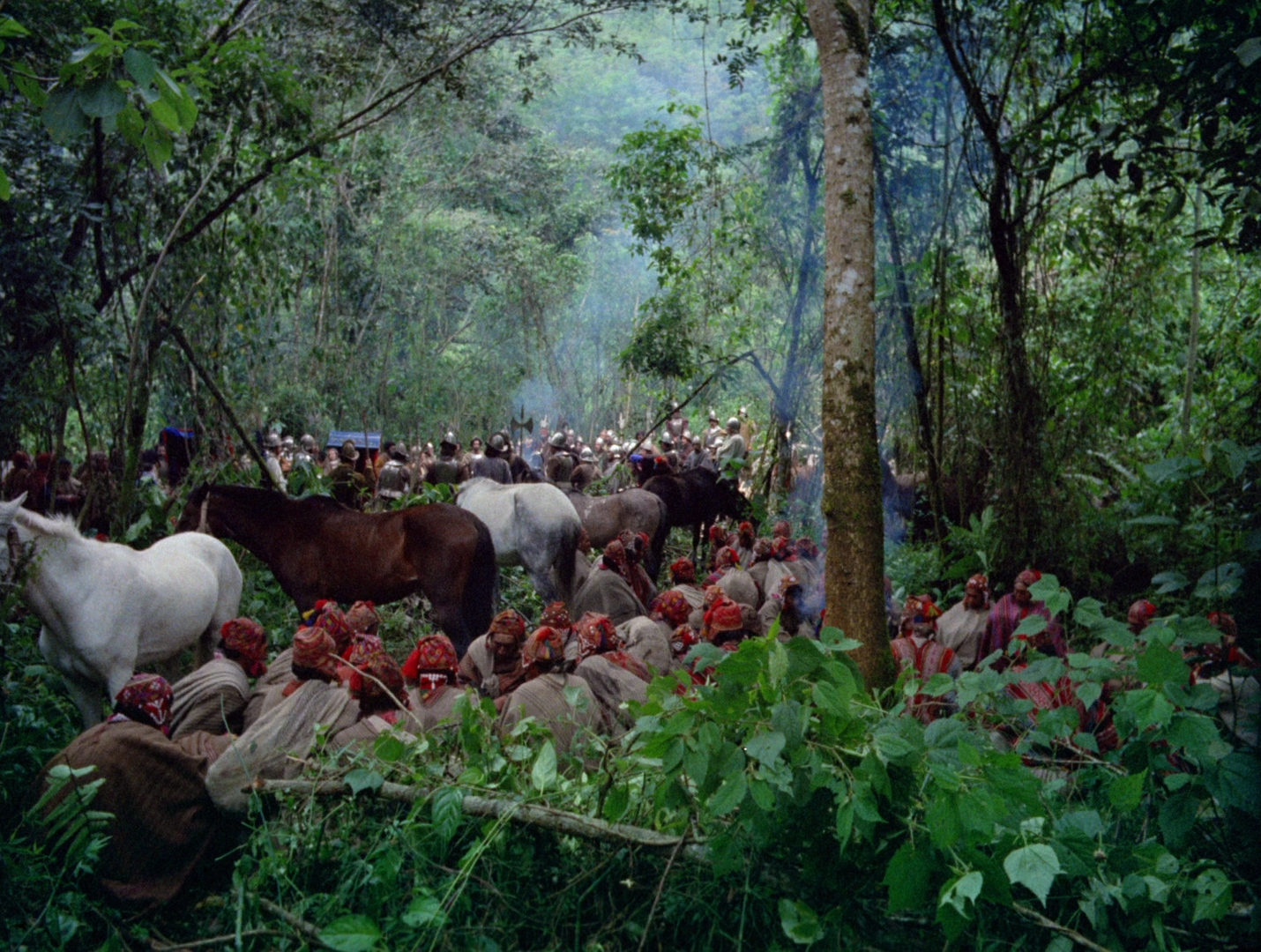
Like Francis Ford Coppola’s Apocalypse Now, which came out a number of years later and cites Herzog’s film as an inspiration, Aguirre traces a pilgrimage into the unknown wilds, driven by hubris and madness and courting death. The story is mostly fictional, dreamed up in a weekend frenzy on a bus trip for a soccer tournament, but is derived from two historical accounts of similar expeditions—campaigns in the 1500s aimed at expanding Spain’s influence and discovering the legendary kingdom of El Dorado.
It becomes clear shortly after the narrative begins that the journey is ill-fated. Gonzalo Pizzaro (Alejandro Repullés), the commander of the expedition, has determined that forcing his diseased and dying forces to hack through dense, swampy jungle and drag cannons over roots and rocks is a futile and foolish enterprise. He selects forty men to scout ahead to determine a suitable course of action. If they do not return within one week, they will be considered lost, and the remaining contingent will abandon the expedition. Don Pedro de Ursúa (Ruy Guerra), a respected soldier, is selected as the party’s leader. Lope de Aguirre (Klaus Kinski), a short-fused renegade, is chosen as second-in-command. Also travelling with the party are Don Fernando de Guzmán (Peter Berling), an overweight nobleman representing the Royal House of Spain; Brother Carvajal (Del Negro), a missionary monk spreading the Word of God to the natives; and two women—Ursúa’s mistress (Helena Rojo) and Aguirre’s daughter (Cecilia Rivera).
Kinksi’s ferocious turn as Aguirre dominates. He is loath to take orders, harbors disdain for his fellow soldiers, and believes he is destined to conquer the natural world. In short order he has inspired a mutiny, killed Ursúa, and installed Guzmán as a figurehead. But just because the hostile environment suits his savage demeanor doesn’t mean his actions are virtuous. Like Carvajal, who masks his greed with a stated desire of proselytization, and the gluttonous Guzmán, Aguirre is hopelessly corrupt. From his new commandeered position, he leads his men forward with promises of riches and glory, forward into a swarm of arrows that rains down on a scouting party so delirious from starvation and disease that they do not believe them to be real. In the end, Aguirre himself remains, crazed and grizzled, still compelled to rally support with a stirring speech and proclaim himself “the wrath of God.”
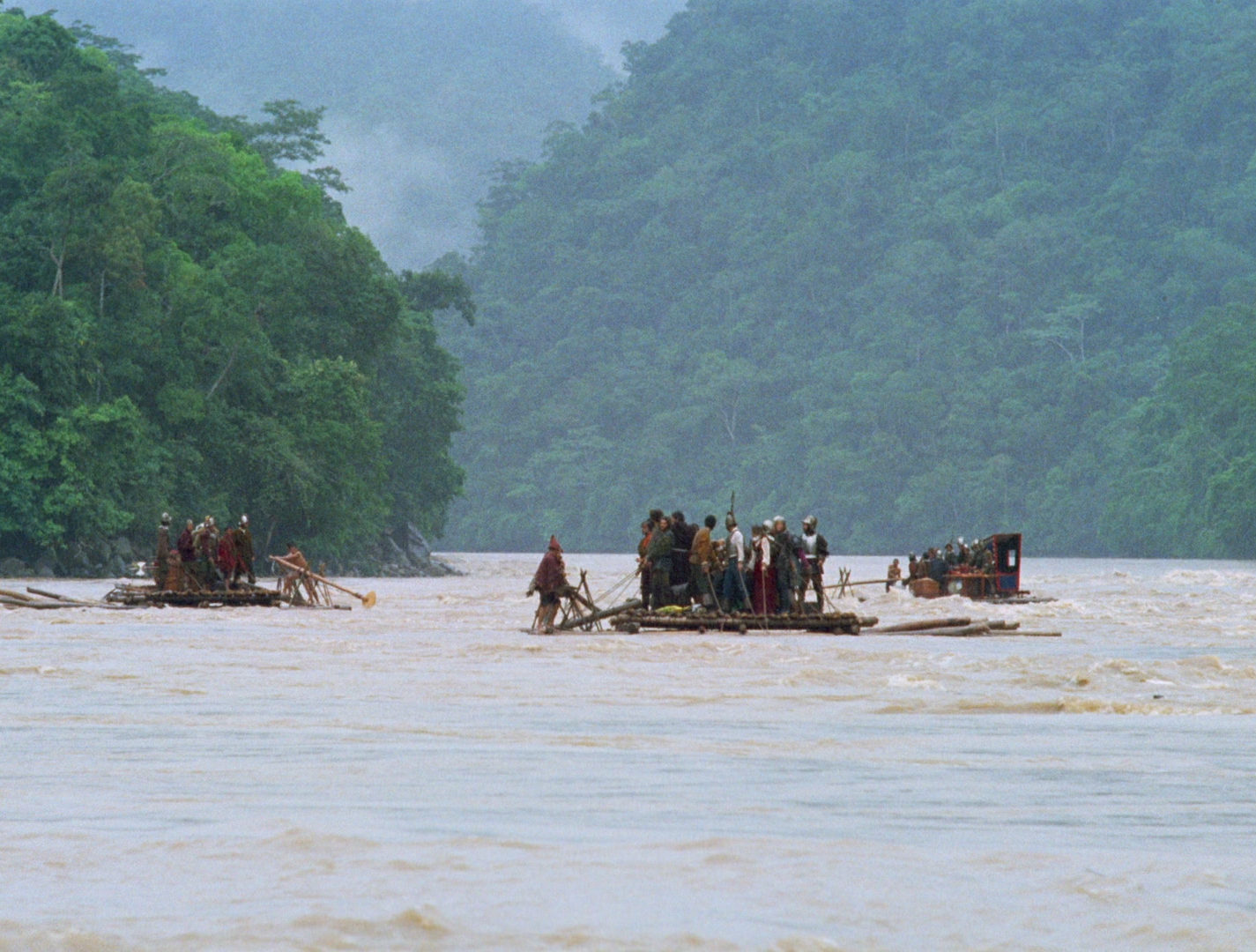
Outside of Aguirre, whose personality is generated as much by Kinski’s mannerisms as anything he says, Herzog seems uninterested in developing characters with any dimensionality. This is a consequence of a more basic decision to focus on mood and image instead of story. Herzog excels in developing a sense of isolation by stranding his cast (and thus his characters, and thus his audience) in the middle of nowhere and filming them. At times it has the unpolished texture of a documentary film, frequently begging the question of how exactly this film was made with any assurance of safety for its cast members. These perilous scenarios bring the director’s unquenchable vision, physical dedication—and of course, his own touch of insane hubris—into focus for the viewer.
Kinski’s wild performance of raving, growling, and snarling is so convincing that his castmates look genuinely scared of him. He prowls around the frame with his head cocked to one side or the other, jerking himself around like a drunken crab, caught between stoic silence and violent outburst. And firsthand accounts would suggest that Aguirre’s descent into a self-destructive ego trip was not much of an act. Herzogian folklore has much to say about Kinski’s outrageous antics during the making of Aguirre, Herzog’s threat to commit a murder-suicide if Kinski did not behave the most prominent of the anecdotes—though not the most alarming. He also was prone to tantrums and apparently hit another actor in the head with his sword (which, of course, was not a prop). During some downtime when some locals were carrying on, Kinski took aim with his rifle and fired a shot into their hut, claiming a finger. In the hands of a lesser filmmaker, Kinski’s rambunctious performance could easily overwhelm the entire film. But the director gently wrests the film away from his unhinged star with a pure, instinctive style. Thomas Mauch’s camera readily observes the majestic flora and fauna of the ancient rainforest while the natural ambience is mixed gracefully with Popol Vuh’s hypnotic Moog and Mellotron theme.
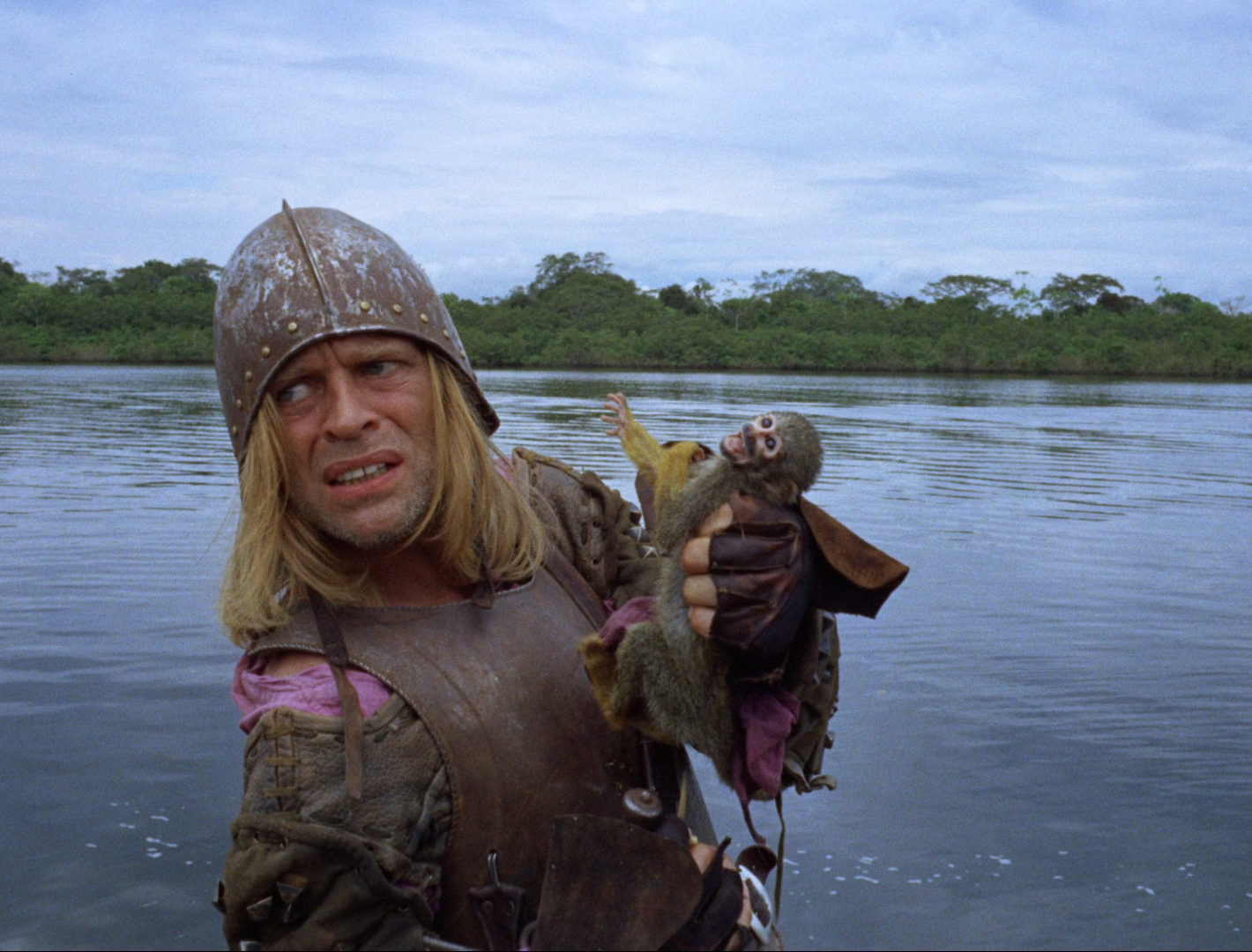
It is with the aid of Florian Fricke’s sublime music that Herzog achieves one of his patented encounters with the surreal. There are hints throughout that lightly immerse the audience in a fever dream—a decapitated head continuing to speak, Ursúa’s wife drifting wraithlike into the forest, human remains decorating the camps of cannibal tribes, pervasive birdsong that drops off to allow the natives to attack the conquistadors in silence. But in the closing moment, as the raft drifts downriver, Aguirre’s men spot a boat stuck impossibly high in a tree. Their reaction is to deem it an illusion. The boat is not real, but then, neither is the forest. Neither are the native arrows that pierce legs and chest nor the lifeblood spilling out of the wounds. Aguirre believes it all to be real, but as he continues alone down the river, raving about his dreams of conquest and dynasty, the camera circles the raft as innumerable monkeys mill about the deck, suitably punctuating Aguirre’s dreamlike state of obsessive madness.
So let’s return to the question of separating the art from the artist. In this case, does it make any sense to consider Aguirre apart from the personalities of Kinski and Herzog? As the lines between fiction and documentary filmmaking are blurred before our eyes, is it appropriate to consider the feature film apart from its committed production? I consider these things inseparable, though if someone comes at it blind I could understand if they are slightly underwhelmed by the basic action and blunt compositions that mostly rely on the spectacle of the environment. But realistically, given the limited budget and size of the production, Aguirre was a pipedream. A pragmatic filmmaker would not have undertaken such an impossible project. But Herzog dared to try and succeeded. He conquered the jungle where his mad Spanish conquistador failed. I’ll happily let that mystique color my perception of the finished film.